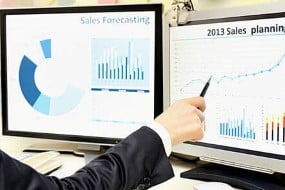Time Series Forecasting in R: A Down-to-Earth Approach
Learn the most effective time series forecasting techniques in this course and become a highly-skilled forecaster. Master the essential components, accuracy metrics, and various forecasting methods like moving averages, exponential smoothing, regression models, ARIMA, and neural networks. Boost your career and earn up to $130,000 as a time series analyst. Perfect for students, data analysts, and anyone interested in developing their skills in time series analysis and forecasting. Join now and gain a critical data science skill!
Know the time series forecasting stepsKnow the essential time series componentsKnow the most important forecasting accuracy metricsUse the moving averages and the simple exponential smoothing techniquesUse the advanced exponential smoothing techniques: Holt and Holt-WintersUse extended exponential smoothing models: TBATS and STLMBuild regression models with trend onlyBuild regression models with trend and seasonalityUnderstand important concepts like autocorrelation, stationarity and integrationUse the augmented Dickey-Fuller test for stationarityBuild autoregressive integrated moving average models (ARIMA)Build neural networks for time series forecastingShow moreShow lessBecome the Best Time Series Expert in Your Organisation!The goal of this course is to convert you into a highly-skilled time series forecaster. You will learn the most effective forecasting techniques that analysts use every day to make accurate predictions about the future. This will make you invaluable for your organisation and help you speed up your career like a flash. A time series analyst makes about $70,000 a year on average, but the top performers can make as much as $130,000 (according to SimplyHired).This course will be a revolution for you, even if you don’t know anything about time series forecasting at this point. After completing it you will know how to…investigate historical data, detect trends and patternschoose the most appropriate forecasting methodsassess forecasting accuracyreduce forecasting errorIn a word, time series forecasting is a critical data science skill. If you want to be a full-blown data analyst you have to master time series.Without further delay, let’s see what you are going to learn in this course.In the first two sections (not counting the introduction) we build the foundations. The second section presents all the steps we must take to perform time series forecasting in practice, while in the third section you will become familiar with the essential time series notions. You will learn about trend and seasonality, time series decomposition, visualising trends, spotting seasonal patterns etc.The fourth section is about evaluating forecasting performance. We will review the most used accuracy metrics for time series forecasting and explain them in detail. (We are going to use them extensively throughout the course.)In the fifth section you will find a brief overview of the forecasting techniques approached in the course. The following sections examine these techniques in great detail and offer practical applications for each, using the R program.The forecasting methods studied in this course are:1. Moving averages (section 6). We don’t have to discard the simple forecasting methods, because sometimes they are more effective than the complex ones. This is why we start by looking into the moving averages, both simple and weighted.2. Simple exponential smoothing (section 7), an extension of the moving averages method. In this section we introduce a very important R function for time series forecasting: ets. More details in the course.3. Advanced exponential smoothing (section 8). Here we delve into really good stuff: we learn to forecast complicated series that present both trend and seasonal patterns. You will become familiar with two powerful models, Holt and Holt-Winters.4. Extended exponential smoothing methods (section 9). In this chapter we will implement state-of-the-art models for series with double seasonality: TBATS and STLM.5. Regression models (section 10). These models can be used for series with both trend and seasonality. They are easy to understand and apply.6. Autoregressive – or ARIMA – models (sections 11 and 12). These models represent a must have tool for any time series forecaster. They can be extremely effective in many situations, since they can make predictions with a remarkable level of accuracy. In these section you’ll learn all-important concepts like autocorrelation, stationarity, integration, autoregressive processes and moving average processes. Afterwards you’ll learn how to identify an ARIMA model using the autocorrelation charts, how to build these models in R and how to use them for forecasting purposes.7. Neural networks (section 13). Here we will deal with a special function that creates neural network models for time series forecasting.Every technique is presented in video, both the syntax and the output being thoroughly explained. At the end of the course, a good number of practical exercises are proposed. This exercises will help you practice and improve your time series forecasting skills.Join this course today and get hold of a mission critical ability – time series forecasting!Who this course is for:Students in any field that requires quantitative forecastsData analystsWanna be data analystsDoctoral studentsAny person who wants to develop their skills in time series analysis and forecasting
User Reviews
Be the first to review “Time Series Forecasting in R: A Down-to-Earth Approach”
You must be logged in to post a review.







There are no reviews yet.